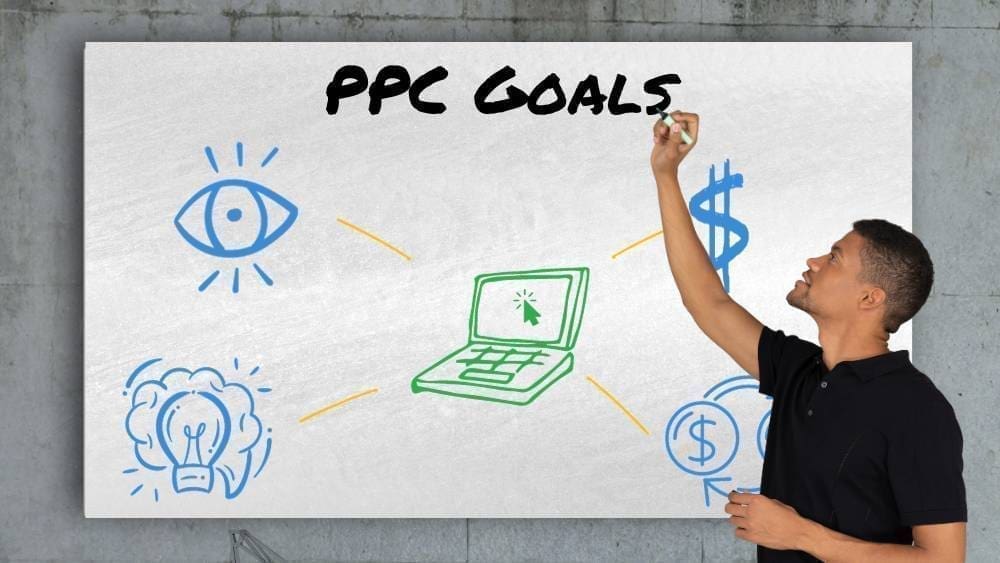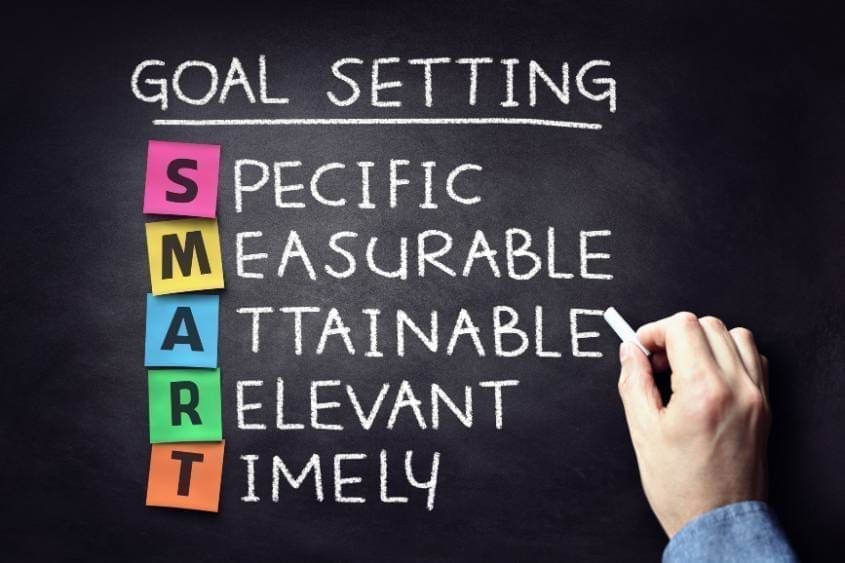
If you’re just starting with pay-per-click (PPC) advertising, your PPC goal might seem straightforward—you want more leads or sales. But, this is only scratching the surface of what PPC can do for your business, and if all you’re doing is focusing on leads or sales, you may be selling your brand short. Give us a few minutes, and we’ll walk you through the most common PPC goals, how they work, when to use them, and how to set PPC goals that align with your unique objectives.
The Significance of Establishing PPC Goals
Start thinking of PPC goals in terms of your customer journey. The concept is similar to a sales funnel, but sales funnels end when the person makes a purchase. The customer journey continues after.
While you may have some prospective clients who are ready to move forward with a purchase or will be once they see your ad, you also have people just starting their journeys. Each interaction along the journey is referred to as a touch point. Each customer may have hundreds of touchpoints, though the average is closer to 2.8 where physical goods are concerned, per Google research. Brands focused on scheduling an initial meeting or conversation should expect eight, according to RAIN Group.
People are more responsive to specific ad types and messaging depending on where they are in the journey. You’ll also have better luck connecting with people on specific channels based on their place in the customer journey.
When you set PPC goals, you’re acknowledging that you’re meeting your prospective customers where they are today and doing what you can to carry them to the next stage of the journey. You’re also setting standards for your brand to meet and helping ensure that your PPC goals align with your digital marketing and business goals.
Common PPC Goals
Because paid ads can help across the entire customer journey, let’s examine PPC goals as they relate to the different stages of the path.
Goal 1: Build Brand Recognition
Potential customers know nothing about your brand at the start of their journey. Most brands should run ads to boost brand awareness as part of their overall goals. However, if your business is new, your company goal is likely just to make people aware that you exist to start.
In these cases, you may run search or shopping ads to catch people looking for what you offer, but not necessarily from your company. You might also be working with display ads to put your brand in front of people who look like your PPC personas or customers.
To warm people up to your brand at this stage, you might offer them content like blogs or downloads to help them solve their problems or walk them through potential solutions. And, you might measure your success in site visits, downloads, or newsletter subscribers.
Goal 2: Encourage Brand or Product Consideration
The modern consumer doesn’t buy anything right away. Instead, they research and compare their options. For instance, a typical consumer will evaluate 1.4 brands before choosing a retail banking company, according to the Journal of Financial Services Marketing. Meanwhile, someone considering a new vehicle will explore 3.8 brands, per McKinsey. Their research also shows someone looking for a personal computer will compare 1.7 brands, those in the market for skincare or telecom services compare 1.5 brands, and auto insurance buyers examine 3.2 brands. Google’s research echoes this and shows that 53 percent of consumers always research before buying, the platform reports.
Search ads can help at this stage, as can remarketing ads if you’re trying to reconnect with people who have already engaged with your brand.
You can help guide people through their decisions by offering things like comparison guides and case studies. As with the previous stage, you’ll likely measure your success in site visits, downloads, or newsletter subscribers.
Goal 3: Generate Leads and Sales
When a prospective customer is nearing readiness, brands can often accelerate decision-making or help nudge the person over the finish line by offering a free demo, consult, or trial. These options work best with search ads or remarketing ads. Success is typically measured with click-through rates and lead form submissions or conversions. Product listing ads and sales may be appropriate for some brands, too.
Goal 4: Boost Loyalty and Repeat Sales
Brands that want to continue building relationships with their customers after purchase typically use remarketing ads. User-generated or educational content, such as how-to guides, often works best in these cases.
How to Set Your PPC Goals
Now that we’ve explored some common goals, ad types, and assets that pair well with them, let’s go over how to turn these concepts into tailored and actionable PPC goals for your business.
Consider Business Needs
Review the company’s overall goals and the goals your marketing team plans to work on that align with them. Because PPC is versatile, you can use your campaigns to support your other efforts and ensure potential customers have a consistent experience regardless of how they connect with your brand.
Identify Short-Term and Long-Term Goals
It’s often helpful to break up your long-term goals into goals you can accomplish in a shorter timeframe or select short-term goals that support your long-term goals.
Let’s say that you run a professional services company, and your long-term goal is to have a client base of 5,000 clients within five years. You’ve broken this up into benchmarks, and your year-one goal is to have 500 clients. Anywhere from ten to fifteen percent of leads become clients, so working backward means you need around 5,000 leads this year or around 417 monthly. Because anywhere from three to five percent of visitors become leads, you need 125,000 annual or 10,417 monthly website visitors to reach your goal.
There are lots of ways to tackle this. For instance, you might want to focus on getting a better conversion rate or increasing visitors. Or, you may approach it from the standpoint of efficiency and reduce your cost per click, so more of your budget goes to the things producing results for you.
Select KPIs
Decide which metrics will be the best indicators of success for your goal. Some common KPIs include:
- Cost per click (CPC)
- Click-through rate (CTR)
- Conversion rate (CVR)
- Cost per lead (CPL)
- Cost per action (CPA)
- Return on ad spend (ROAS)
- Ad Quality Score
Formulate SMART Goals

Next, you’ll convert your goals into SMART goals. SMART goals are:
- Specific
- Measurable
- Achievable or Attainable
- Relevant
- Timebound or Timely
Specific
“Specific” typically references the who, what, where, when, and why. Let’s say that your overreaching goal is to boost brand recognition. Your SMART goal might begin with: “Leverage search ads on Google and Microsoft to boost website traffic.”
Measurable
The KPIs covered above and traditional website metrics are often used as measures of success. To make our PPC goal measurable, we might break down the yearly traffic goal into a monthly goal, such as: “Leverage search and display ads on Google and Microsoft to generate 10,417 visitors per month.”
Achievable
You’re unlikely to keep working toward goals that aren’t realistic. There are lots of different ways to ensure they are. For instance, you may gain insights by reviewing previous campaigns and website analytics. You can also use PPC benchmarks to see if your goals are achievable if you’re running ads for the first time or don’t have strong historical data.
We can expect to pay $3.31 per click based on benchmarks if our search budget is split evenly between the two platforms. That means to get 10,417 extra monthly visitors, we’ll need to spend $34,480. Our example company has a $35,000 monthly budget, so our goal is achievable. However, if we didn’t have this size of budget, we’d need to reduce our goals or shift the budget to make room for this expense.
Relevant
“Relevant” refers to whether your PPC goal ties back to marketing and business goals. We worked backward from our long-term company goal of having 5,000 clients in five years to determine how many leads and visitors we need, so our goal “Leverage search and display ads on Google and Microsoft to generate 10,417 visitors per month” is relevant.
If our company also has profit-related goals, we might want to crunch the expenses compared to customer lifetime value (CLV). We should be producing 417 leads or 42 customers per month at this volume, which means each lead costs us $83, and each customer costs $821. That may seem high, but it’s nothing compared to what the business brings in for that customer. For instance, the average CLV for a business operations consulting firm is $136,959, according to First Page Sage.
You may eventually be able to whittle down your costs or increase your CLV. However, your company is in an excellent position if it meets these goals.
Timebound
The last component involves locking yourself into a timeframe so you know when to measure your results and assess your success. We’ve covered several timeframes here, but we’ve broken our smaller goal into monthly milestones, so we’ll slightly adjust the goal to indicate when we’ll measure.
“Leverage search and display ads on Google and Microsoft to generate 10,417 visitors next month” is timebound. It now meets all the criteria for a SMART goal.
Implement, Track Results, and Refine
Your PPC campaigns won’t begin operating at peak efficiency. You’ll need to make minor adjustments as you go, such as weeding out inefficient keywords and ad groups. You’ll also need to add negative keywords to preserve your ad spend for potential customers who are a better match for what you do and are more likely to take action. Expect slower progress toward your PPC goals to start because of this.
If you find that you’re still missing your targets after a couple of months and results aren’t starting to improve, it may be time to reevaluate your PPC goals or bring in an experienced PPC agency that can help you get the results and ROI your business deserves.
Get Help Reaching Your PPC Goals
If you’re struggling to reach your PPC goals or need help aligning your PPC strategy with business objectives, budgets, and other aspects outlined here, get the insights you need from a pro. Request a complimentary consultation.


















